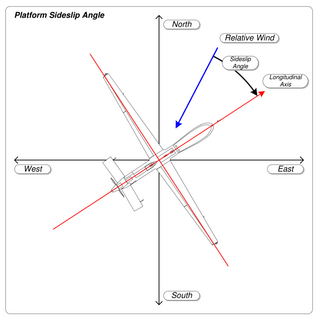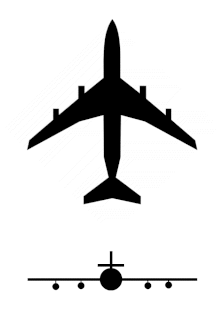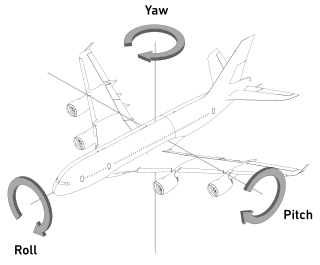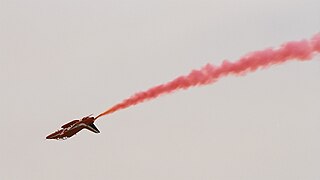
An aileron is a hinged flight control surface usually forming part of the trailing edge of each wing of a fixed-wing aircraft. Ailerons are used in pairs to control the aircraft in roll, which normally results in a change in flight path due to the tilting of the lift vector. Movement around this axis is called 'rolling' or 'banking'.

In fluid dynamics, a stall is a reduction in the lift coefficient generated by a foil as angle of attack increases. This occurs when the critical angle of attack of the foil is exceeded. The critical angle of attack is typically about 15 degrees, but it may vary significantly depending on the fluid, foil, and Reynolds number.
Slow flight is a portion of an airplane's performance envelope above the speed at which the plane will stall, but below the aircraft's endurance speed. This part of the performance chart is also known as "the back side of the power curve" because when flying in this area, more power is required to fly at a speed lower than the minimum drag speed and still maintain straight and level flight. A large angle of attack is required in order to maintain the altitude of the aircraft.
A spin is a special category of stall resulting in autorotation about the aircraft longitudinal axis and a shallow, rotating, downward path approximately centred on a vertical axis. Spins can be entered intentionally or unintentionally, from any flight attitude if the aircraft has sufficient yaw while at the stall point. In a normal spin, the wing on the inside of the turn stalls while the outside wing remains flying. It is possible for both wings to stall, but the angle of attack of each wing, and consequently its lift and drag, are different. Either situation causes the aircraft to autorotate toward the stalled wing due to its higher drag and loss of lift. Spins are characterized by high angle of attack, an airspeed below the stall on at least one wing and a shallow descent. Recovery and avoiding a crash may require a specific and counter-intuitive set of actions.

Aircraft flight control surfaces are aerodynamic devices allowing a pilot to adjust and control the aircraft's flight attitude.
Control reversal is an adverse effect on the controllability of aircraft. The flight controls reverse themselves in a way that is not intuitive, so pilots may not be aware of the situation and therefore provide the wrong inputs; in order to roll to the left, for instance, they have to push the control stick to the right, the opposite of the normal direction.

In aeronautics, a spoiler is a device intended to intentionally reduce the lift component of an airfoil in a controlled way. Most often, spoilers are plates on the top surface of a wing that can be extended upward into the airflow to spoil the streamline flow. By so doing, the spoiler creates a controlled stall over the portion of the wing behind it, greatly reducing the lift of that wing section. Spoilers differ from airbrakes in that airbrakes are designed to increase drag without affecting lift, while spoilers reduce lift as well as increasing drag.

A slip is an aerodynamic state where an aircraft is moving somewhat sideways as well as forward relative to the oncoming airflow or relative wind. In other words, for a conventional aircraft, the nose will be pointing in the opposite direction to the bank of the wing(s). The aircraft is not in coordinated flight and therefore is flying inefficiently.

Dutch roll is a type of aircraft motion, consisting of an out-of-phase combination of "tail-wagging" (yaw) and rocking from side to side (roll). This yaw-roll coupling is one of the basic flight dynamic modes. This motion is normally well damped in most light aircraft, though some aircraft with well-damped Dutch roll modes can experience a degradation in damping as airspeed decreases and altitude increases. Dutch roll stability can be artificially increased by the installation of a yaw damper. Wings placed well above the center of gravity, sweepback and dihedral wings tend to increase the roll restoring force, and therefore increase the Dutch roll tendencies; this is why high-winged aircraft often are slightly anhedral, and transport-category swept-wing aircraft are equipped with yaw dampers. A similar phenomenon can happen in a trailer pulled by a car.

Aerobatic maneuvers are flight paths putting aircraft in unusual attitudes, in air shows, dogfights or competition aerobatics. Aerobatics can be performed by a single aircraft or in formation with several others. Nearly all aircraft are capable of performing aerobatics maneuvers of some kind, although it may not be legal or safe to do so in certain aircraft.
Flight mechanics are relevant to fixed wing and rotary wing (helicopters) aircraft. An aeroplane, is defined in ICAO Document 9110 as, "a power-driven heavier than air aircraft, deriving its lift chiefly from aerodynamic reactions on surface which remain fixed under given conditions of flight".

American Airlines Flight 157, a Douglas DC-6, departed on November 29, 1949, from New York City bound for Mexico City with 46 passengers and crew. After one engine failed in mid-flight, a series of critical mistakes by the flight crew caused the pilot to lose control of the plane during the final approach to a routine stopover at Love Field in Dallas, Texas. The airliner slid off the runway and struck a parked airplane, a hangar, and a flight school before crashing into a business across from the airport. 26 passengers and two flight attendants died. The pilot, co-pilot, flight engineer, and 15 passengers survived.
Adverse yaw is the natural and undesirable tendency for an aircraft to yaw in the opposite direction of a roll. It is caused by the difference in lift and drag of each wing. The effect can be greatly minimized with ailerons deliberately designed to create drag when deflected upward and/or mechanisms which automatically apply some amount of coordinated rudder. As the major causes of adverse yaw vary with lift, any fixed-ratio mechanism will fail to fully solve the problem across all flight conditions and thus any manually operated aircraft will require some amount of rudder input from the pilot in order to maintain coordinated flight.

A barrel roll is an aerial maneuver in which an airplane makes a complete rotation on both its longitudinal and lateral axes, causing it to follow a helical path, approximately maintaining its original direction. It is sometimes described as a "combination of a loop and a roll." The g-force is kept positive on the object throughout the maneuver, commonly between 2–3 g, and no less than 0.5 g. The barrel roll is commonly confused with an aileron roll.
The dynamic stability of an aircraft refers to how the aircraft behaves after it has been disturbed following steady non-oscillating flight.

In aviation, coordinated flight of an aircraft is flight without sideslip.

An aircraft in flight is free to rotate in three dimensions: yaw, nose left or right about an axis running up and down; pitch, nose up or down about an axis running from wing to wing; and roll, rotation about an axis running from nose to tail. The axes are alternatively designated as vertical, transverse, and longitudinal respectively. These axes move with the vehicle and rotate relative to the Earth along with the craft. These definitions were analogously applied to spacecraft when the first manned spacecraft were designed in the late 1950s.

Radio-controlled aerobatics is the practice of flying radio-controlled aircraft in maneuvers involving aircraft attitudes that are not used in normal flight.

A slow roll is a roll made by an airplane, in which the plane makes a complete rotation around its roll axis while keeping the aircraft flying a straight and level flightpath. A slow roll is performed slower than an aileron roll; although it is not necessarily performed very slow, it is performed slow enough to allow the pilot to maintain balance, keeping a steady flightpath, pitch angle, and height (altitude) throughout the maneuver. The maneuver is performed by rolling the airplane at a controlled rate with the ailerons, and moving the elevators and rudder in opposition, or "cross-controlling," to keep the plane on a steady, level flightpath.

A falling leaf is an aerobatic maneuver in which an aircraft performs a wings-level stall which begins to induce a spin. This spin is countered with the rudder, which begins a spin in the opposite direction that must be countered with rudder, and the process is repeated as many times as the pilot determines. During the maneuver, the plane resembles a leaf falling from the sky; first slipping to one side, stopping, and then slipping to the other direction; continuing a side-to-side motion as it drifts toward the ground.















